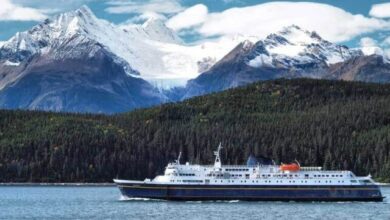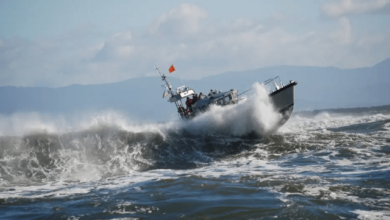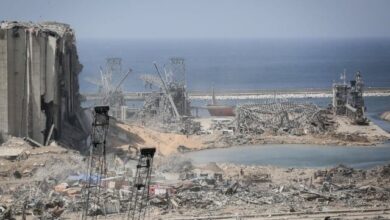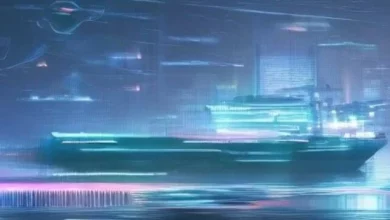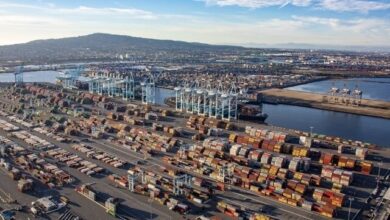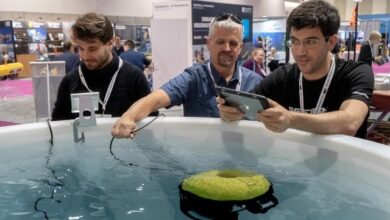Ports : Global rise of small wind turbines from the port of Rotterdam

Flower Turbines work in a different way to the wind turbines
They are flower-shaped, stand 1, 3 or 6 metres tall and come in any colour. Put them on your motorhome, house, commercial building or car park and voilà, even when there’s little wind, they start spinning and produce power. Flower Turbines wind turbines are on a rapid, global and sustainable rise. Director Roy Osinga: ‘Flower Turbines support the energy transition in an aesthetically pleasing way, and they’re coming to the Port of Rotterdam.’
For example, a 6-metre turbine will be installed in the Amaliahaven on Maasvlakte 2. Osinga: ‘We are working closely on this project with the Port of Rotterdam Authority. The turbine will produce renewable power that will be put to various uses in the port, starting probably in the second quarter of 2021.’
What explains the rapidly increasing success of the turbines? From the green carpet on the site of Rotterdamse Droogdok Maatschappij (Rotterdam Drydock Company, RDM), an inspired Osinga says: ‘We are facing the huge challenges of the Green Deal. The energy transition is really buzzing now. Companies and individuals alike are keen to do something and they are seeking solutions.
We are offering them the chance of generating power even when the sun isn’t shining. The big energy turnaround is already underway and sometimes it’s the smaller companies that are leading the way. Sustainability already comes much more naturally to them than it does to some of the major energy consumers and polluters.’
On roofs or car parks
Flower Turbines work in a different way to the wind turbines we’re used to seeing. Osinga: ‘This is due to the aerodynamic design, the inner shape of the two turbine segments and their positioning in relation to each other.
They make it possible to convert some of the energy contained in the wind into renewable electricity. The turbines operate from any wind direction and start turning relatively quickly. This means the wind turbine operates for many more hours, which in turn produces a higher yield.’
‘The amount of power a turbine produces depends of course on aerodynamics, its size and the strength of the wind. With two 3-metre turbines, you can power a considerable section of a home. The 6-metre turbines are an excellent option for large-scale or corporate power generation. If you place these turbines in clusters close to each other, productivity multiplies.
They are therefore highly suited to, say, companies with strong roofs or outdoor car parks.’ There are even more advantages to this kind of wind turbine. Osinga: ‘They’re so quiet, you can comfortably work or live next to them. They don’t produce any shadow flicker and they are bird-friendly.
In this way, they are different from conventional wind turbines. The fact that the turbines can be easily installed on roofs and in the built environment means you don’t need additional land or bodies of water on which to place them. In short, they have less of an impact on the living environment, which is helped by the fact that they make less noise than conventional wind turbines.’
Inspired by nature
The idea behind Flower Turbines was conceived by Israeli Daniel Farb almost eight years ago. He signed up for PortXL, the Rotterdam start-up programme designed to help innovative and sustainable companies move forward. After a successful pitch in the Netherlands, he got in touch with Osinga.
Osinga is a business economist and entrepreneur who has previously worked both for and with government organisations, businesses and tech start-ups in ICT, construction and sustainability. Osinga became enthusiastic and he and Farb together took the decision to make Flower Turbines big in the Netherlands and the rest of Europe. In 2019, the company landed at RDM.
But where does the flower reference originate? Osinga explains: ‘Daniel’s parents come from the world of art and science. I myself am inspired by nature, and as a sailor I am familiar with the power of the wind. The combination of technology and art is reflected in the design. And with its organic lines, the wind turbine looks like a tulip. Of course, that also makes it a wonderfully iconic export product.’

Things that matter
For Osinga, joining forces with Farb was a logical step: ‘I have spent my life working for organisations that were shaping transitions. I enjoy being involved in things that matter. Although starting a new business is really hard work, it’s also very rewarding. It’s great to see everything coming together and how we and the rest of the team are making progress.’
Since last year, Flower Turbines has been enjoying fast-growing recognition. We have had orders from all over Europe and there has been an increasing interest from the United States. Osinga: ‘A year ago, there was just me and Daniel.
There are now ten permanent members in our team and we are currently in the transition phase between start-up and scale-up. We need a lot of cash to be able to produce the turbines in large numbers. Using crowdfunding, we have so far managed to raise almost €2 million.’
Manufacturing companies that dare
How do you like RDM? Osinga: ‘RDM is a true innovation hub where it’s easy to meet other technology experts. We have outsourced the manufacture of components for our products to various factory locations. Here at RDM, though, where we are surrounded by other companies that are not afraid to do and dare, we are working hard on new developments.
It’s a great match. The manufacturing industry is justifiably on the rise. What international political developments and the coronavirus have taught us is that we still need to collaborate internationally and that we must be able to stand on our own two feet. By investing in the manufacturing industry, we become less dependent on others. In that regard, RDM plays a pioneering role.’
Golden tulip
Who is buying your wind turbines? Osinga: ‘The 1-metre turbines are mainly being bought by private individuals, but we have also sold to SMEs, and several have already been delivered. We are also supplying our 3-metre turbines. The first 6-metre turbine will be ready for testing in early 2021.
That’s another massive leap forward! The larger turbines are going to governments, organisations and entrepreneurs. Governments are actively supporting sustainability by joining us to show how it can be done. Some entrepreneurs in the port are also prioritising sustainability. You can see that they want more and more. Others are also recognising the benefits; for instance, a gold-coloured turbine is being fitted onto the roof of an apartment complex.
The developer wants to use it to inspire others and show them that there is an attractive way of using the wind to generating your own power.’
Hybrid system of power generation
In Osinga’s opinion, we need to combine technologies. ‘There is no single solution. The solution is a mix of resources. Although solar panels are an example of clean energy, they are of little use at night. Batteries are still expensive and they are certainly not always sustainable. Using Flower Turbines is therefore a great way to complement solar panels. I think we’re moving towards a hybrid system of generating energy, in which you get some of your power from central utility companies, some from geothermal energy and ground heat, and some from your own equipment, such as panels and turbines.’
Chain reaction
Osinga believes the turbines also have an inspirational effect: ‘It’s great that people are happy with our products. This creates a lot of positive energy. You can solve part of the energy problem with small wind turbines. They are an inspiration to a lot of people and you should never underestimate how valuable that is! When companies show they’re adopting new technology, it can inspire others to follow in their footsteps. The way I see it is that it acts as a catalyst, and its value is greater than simply the yield from the turbines.’

Nature conservation
What would Osinga like to see done better or differently in the port of Rotterdam? ‘We really need to conserve the natural environment and biodiversity in the port area. Wherever possible, let’s generate the power needed for the built environment and industry in the same built environment.
That way we can conserve nature! By putting solar panels in grasslands, we are simply making our mark there again. We grew the urban environment, so we have already taken that space away from nature. Our quiet and easily installed turbines fit naturally into the urban landscape. This will help us ensure that nature is allowed to hold on to its own space.’
Tips for other companies
‘As well as our Flower Turbines, we also develop and supply solar and wind-powered charging products for bicycles, scooters and mobility scooters. You can use them both on-grid and off-grid*. These are just a few examples of how as a company, local authority or organisation you can complete your energy circle.’



